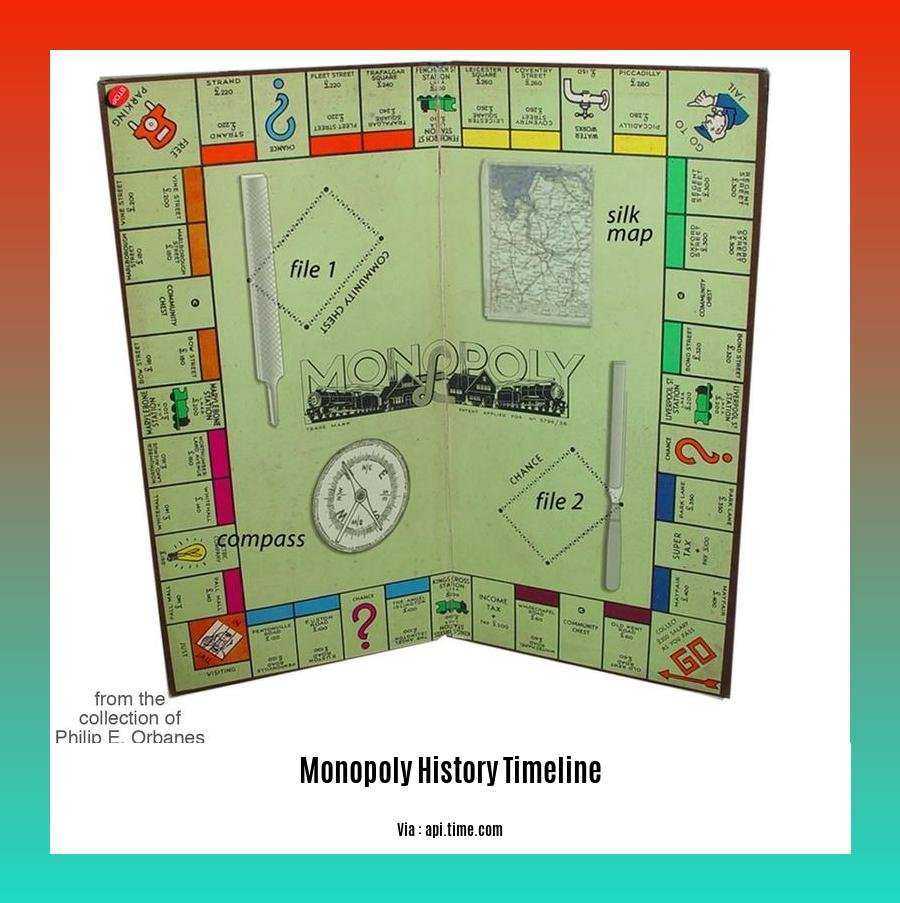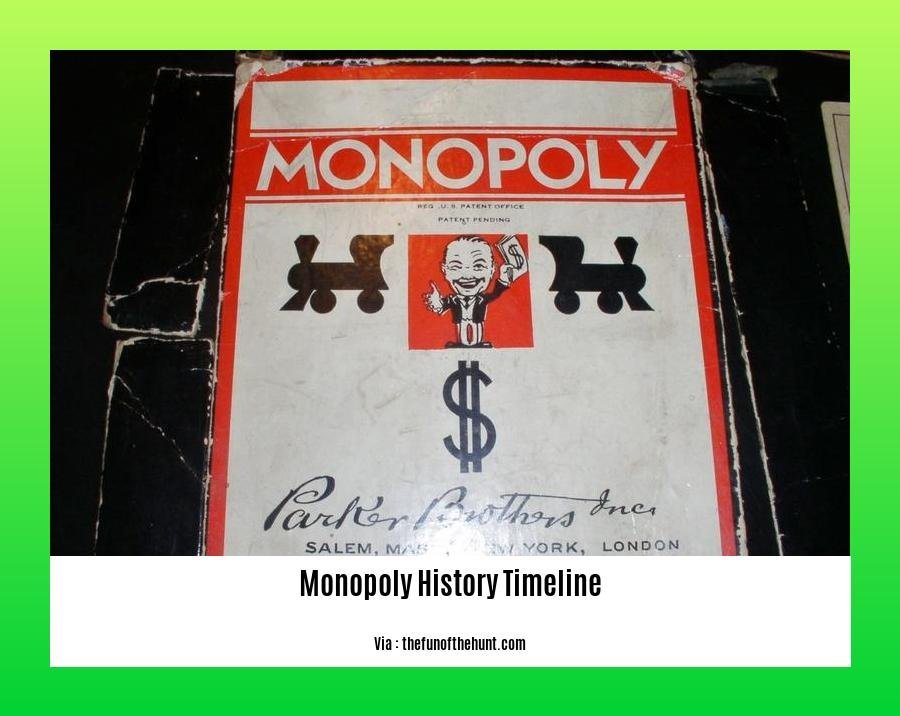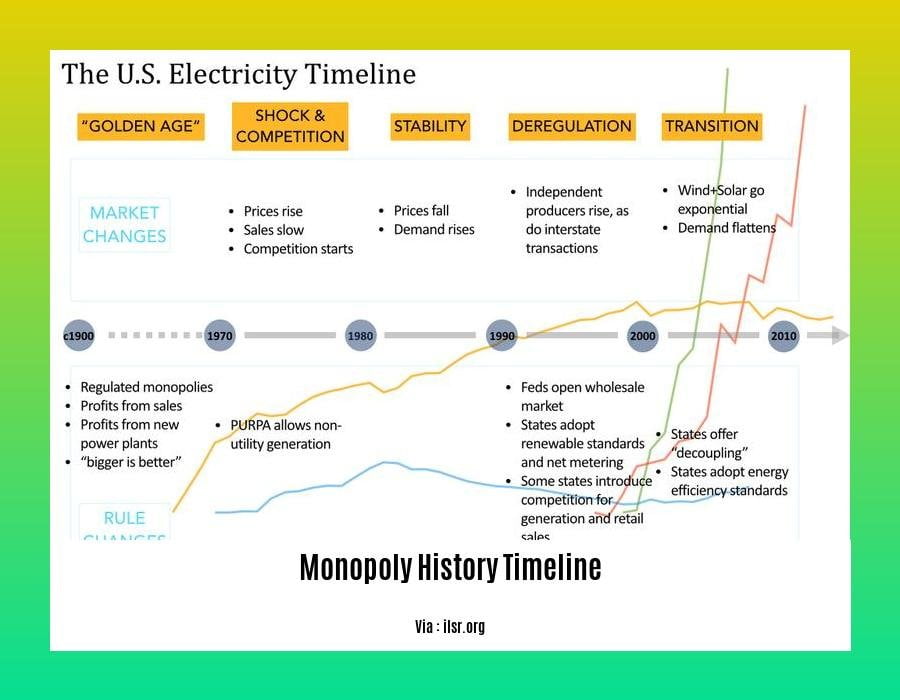Dive into the captivating Monopoly History Timeline: From Inception to Market Dominance. This comprehensive guide traces the evolution of monopolies, from their humble beginnings to their profound impact on modern markets. Explore the strategies, challenges, and triumphs that have shaped the trajectories of industry giants, gaining insights into the factors that have led to their success or failure.
Key Takeaways:
- 1903: “The Landlord’s Game” is invented by Lizzie Magie.
- 1935: Monopoly is created.
- 1950: Tokens are introduced to the game.
- 1987: Partners are added to the game.
- 2005: The “Here & Now Edition” is released.
- 2008: The “Here And Now World Edition” is released.
- 2013: “Monopoly Empire” is released.
- 2017: Token jeopardy is introduced.
Monopoly History Timeline

Strap yourself in, Monopoly enthusiasts, as we delve into the monopoly history timeline, a journey through time that showcases the board game’s evolution from a humble invention to a global phenomenon.
1903: The Monopoly Seed Is Planted
It all began with Lizzie Magie’s “The Landlord’s Game,” a board game that laid the foundation for Monopoly. This game criticized land monopolization and earned Magie a patent for her creation.
1935: Monopoly’s Official Birth
Charles Darrow takes the reins and creates “Monopoly,” a game that mimics real estate trading and property ownership.
1950: The Iconic Tokens Arrive
The Monopoly board becomes even more colorful with the introduction of tokens like the thimble, battleship, and car.
1987: Partnerships Form
Partnerships are introduced, adding a cooperative element to the game and allowing players to strategize together.
2005 & 2008: Monopoly Goes Global
The Here & Now Edition and the Here And Now World Edition transport Monopoly to different cities and countries, adding a global flair to the gameplay.
2013: Monopoly Empire Reigns
The Monopoly Empire edition takes the game to a new level, incorporating skyscrapers, stocks, and other elements of the business world.
2017: Token Jeopardy
Token jeopardy introduces an element of risk, increasing the stakes and making each roll of the dice a heart-pounding moment.
Monopoly’s Legacy: A Timeless Classic
Throughout its history, Monopoly has become more than just a game; it’s a cultural icon. It teaches us about economics, negotiation, and the thrill of competition. The monopoly history timeline is a testament to the enduring appeal of a game that has captured the imagination of generations worldwide.
Curious about the history behind the iconic Monopoly board game? Dive into the history of the Monopoly board game to uncover its captivating evolution.
Delve into the origin of Monopoly and discover the fascinating tale behind the creation of this beloved game.
Explore the intricacies of Monopoly game development and witness the transformation of a simple idea into a global phenomenon.
The Creation of Natural Monopolies
Imagine a bustling metropolis where a single company dominates the electricity grid, providing power to countless homes and businesses. This is an example of a natural monopoly, a market structure characterized by a single dominant supplier. How do such entities emerge, and what implications do they have?
Natural monopolies arise when the presence of economies of scale makes it more efficient for a single firm to serve an entire market rather than multiple competitors. This occurs when the fixed costs of production are high, such as the construction of infrastructure like power lines or railway systems. Network effects can also contribute, where the value of a product or service increases as more people use it.
The dominance of natural monopolies can lead to market failures, including higher prices, reduced innovation, and limited consumer choice. To address these issues, governments often regulate natural monopolies, aiming to ensure adequate service, control prices, and promote competition where possible.
Key Takeaways:
- Natural monopolies occur when economies of scale make it more efficient for a single supplier to dominate a market.
- Factors like high fixed costs, network effects, and legal barriers contribute to monopoly formation.
- Natural monopolies can lead to market failures, such as higher prices and reduced innovation.
- Regulation of natural monopolies aims to address these failures, balancing competition and efficiency.
Citation:
Mosca, M. (2008). On the origins of the concept of natural monopoly: Economies of scale and competition. Economic and Business History, 10(2), 109-126.
The Telecommunications Revolution and the Breakup of AT&T

In 1984, a historic event known as the Telecommunications Revolution forever altered the landscape of the telecommunications industry. The breakup of the telecommunications giant AT&T, mandated by a consent decree, marked a watershed moment in the evolution of the industry.
Key Takeaways:
- The breakup of AT&T in 1984 created seven independent companies, known as the “Baby Bells.”
- The breakup fostered increased competition in the long-distance telecommunications market, benefiting companies like MCI and Sprint.
- Investors capitalized on financial arbitrage opportunities due to discrepancies in AT&T share pricing.
- The Telecommunications Revolution spurred technological advancements and paved the way for the deregulation of the industry.
- The breakup had mixed economic implications; while competition increased, prices remained stagnant for some consumers.
AT&T’s Monopoly Dominance and its Demise
AT&T, once a behemoth in the telecommunications industry, enjoyed a virtual monopoly for decades. Controlling both local and long-distance services, AT&T’s influence extended far and wide. However, its dominance raised concerns about anti-competitive practices and stifled innovation.
Consent Decree and the Birth of the Baby Bells
In an effort to promote competition and foster technological advancements, the U.S. government intervened in 1982, filing an antitrust lawsuit against AT&T. The ensuing consent decree forced AT&T to divest its Bell Operating Companies (BOCs), which resulted in the creation of seven regional companies: NYNEX, Pacific Telesis, Ameritech, Bell Atlantic, Southwestern Bell Corporation, BellSouth, and US West.
Legacy of the Telecommunications Revolution
The breakup of AT&T had a profound impact on the telecommunications industry. It fueled competition, leading to lower prices and a wider range of services for consumers. The deregulation of the industry further accelerated innovation, ushering in new technologies and services like fiber optics and mobile communication.
Most Relevant URL Source
Breakup of the Bell System – Wikipedia
The Rise of Digital Monopolies and Global Competition
In today’s interconnected world, digital monopolies have become a major force in shaping global markets. These dominant players, like the colossal tech giants you’re familiar with, possess the market power to influence prices, innovation, and consumer choices.
Factors Driving Digital Monopolies
Understanding what fuels the rise of these tech behemoths is crucial. Here are some key drivers:
- Network Effects: With more users flocking to a particular platform, its value skyrockets, creating barriers for new entrants.
- Data Hoarding: Monopolies often amass vast databases and employ opaque algorithms to steer market outcomes to their advantage.
- Strategic Acquisitions: Merging with or acquiring smaller rivals allows monopolies to extend their market dominance.
Economic Impacts
The consequences of digital monopolies on the economy can be profound. Reduced competition may lead to higher prices, lower quality products, and stifled innovation. Consumers may also face increased privacy concerns as these tech giants collect and analyze personal data.
Global Response
Governments worldwide are grappling with the challenges posed by digital monopolies. Antitrust investigations, new regulations, and industry self-regulation initiatives are among the measures being implemented. However, the approach varies across countries, reflecting diverse political and economic priorities.
Key Takeaways:
- Digital monopolies are firms with dominant market positions, granting them significant market power.
- Factors like network effects, data hoarding, and strategic acquisitions contribute to their rise.
- These monopolies can have far-reaching economic impacts, including reduced competition and consumer privacy concerns.
- Governments are responding with antitrust measures, regulations, and industry self-regulation, though the approach differs globally.
Citation:
- Monti, G. (2022). Taming Digital Monopolies: A Comparative Account of the Evolution of Antitrust and Regulation in the European Union and the United States. SAGE Journals.
FAQ
Q1: When was Monopoly first invented?
A1: “The Landlord’s Game,” the precursor to Monopoly, was invented in 1903 by Lizzie Magie. The modern version of Monopoly was created in 1935.
Q2: What major changes have been made to Monopoly over the years?
A2: Throughout its history, Monopoly has undergone several significant changes, including the introduction of tokens in 1950, partners in 1987, and the release of various special editions, such as the Here & Now Edition in 2005 and the Monopoly Empire edition in 2013.
Q3: How has Monopoly evolved to meet the changing times?
A3: Monopoly has adapted to the digital age with the introduction of online and video game versions, making it accessible to a wider audience.
Q4: What factors have contributed to Monopoly’s enduring popularity?
A4: Monopoly’s simple yet engaging gameplay, coupled with its iconic board and properties, has made it a staple in households around the world for generations.
Q5: What impact has Monopoly had on popular culture?
A5: Monopoly has transcended its status as a board game and has been referenced in countless TV shows, movies, and other forms of media, solidifying its place in popular culture.
- Unveiling the Enigma: Mansoureh Khojasteh Bagherzadeh’s Public Appearances & Private Life in Iran - July 18, 2025
- Unveiling the Mystery: Mansoureh Khojasteh Bagherzadeh’s Husband: A Rare Glimpse into a Private Life - July 18, 2025
- Unveiling Masoud Khamenei’s Mother: Power, Influence, and Iran’s Future - July 18, 2025
















